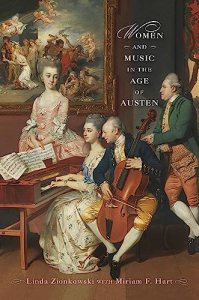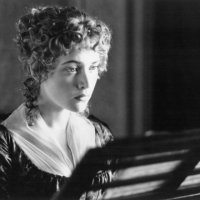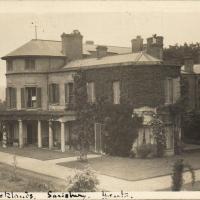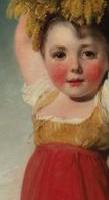Early Letter: Writer (finally) Identified
The online catalogue to the Hampshire Record Office gave this description for folder /101/:
Friends, Acquaintances and Distant Relatives of the Austen-Leigh Family
[no ref. or date]
Letters 23M93/101/1 c.1812-1978 & n.d.
Contents:
Letter to Mrs Englefield, former Nanny, from Edward-Compton Austen-Leigh, 1851
Copy letter in rhyme to Lord Powlett, from [?T] Smith, 1865
Letter to ‘Miss Smith’ from unidentified sender, in French, n.d. 19th cent.
Letter to Marianne Yerbury from G. Blaikall, n.d. (19th cent)
Letter to Dr. Chapman from Margaret Bellasis, concerning family’s Austen connections, 1953
Letter to Mrs Evelyn Fowle from Diana Hopkinson, 1978
As you might imagine, anything dated 1950s and 1970s were of less interest to my particular research into the family of Emma Austen Leigh, 1801-1876, the wife of James Edward Austen Leigh (Jane Austen’s nephew).
I photographed what seemed most of interest, or – in this particular case – most MYSTERIOUS.
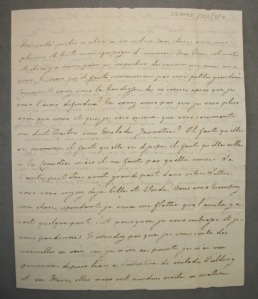
This is the first page (of only two pages – though it seems complete) of the letter identified as
Letter to ‘Miss Smith’ from unidentified sender, in French, n.d.
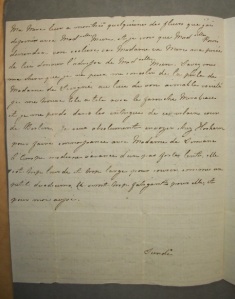
Plenty of ROOM – the day (“Lundi”, Monday) written in a largely open space; page 3 (which faces the page 2 in the photograph) is wholly blank.
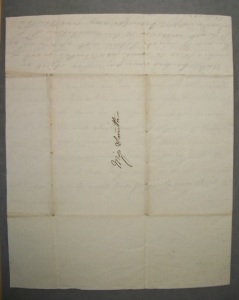
The last (fourth) page has room, too – despite the woefully CURT direction. “Miss Smith” – no address (which would have helped). Suttons or Portland Place would have indicated eldest sister Augusta Smith (keep in mind, I don’t own this letter, so I cannot check the WATERMARK for an indication of the PAPER’s date). Or, was it older, eighteenth century rather than nineteenth century – and the addressed “Miss Smith” one of the Four Smith Sisters of Erle Stoke Park???
As each elder sister married, the title of “Miss Smith” passed down the line – from Maria (married 1787) to Eliza (married 1793) to Augusta (married 1798) to Emma (remained unmarried). All younger sisters were Miss-firstname (or initial)-lastname. THIS is a never-wavering convention of the time.
BTW, this blog post called “Further Thoughts” on the sisters, was written earlier than the link above; it gives a bit more information on this group of ladies.
The first link, though, gives IMAGES of their handwritten letters. From those you will see that NONE of the Erle Stoke sisters penned The Mystery Letter. The eldest sister (Maria) has a very distinct, somewhat child-like hand; the next sister (Eliza) has a somewhat crabbed hand – I find it less readily recognizable than the other three; the third sister (Augusta) (Emma Smith’s mother) has a very distinct hand, very clear with immediately-recognizable characteristics; the youngest sister (Emma) (yes another Emma Smith. There actually were THREE Emma Smiths, one in three successive generations) has the more difficult hand, though in her earliest days the writing WAS easier (for me) to read.
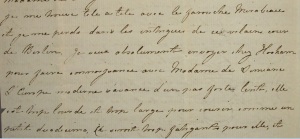 CLICK image for full size
CLICK image for full size
The Mystery Letter
I photographed The Mystery Letter because it stated, a couple of times, the name Miss Meen — though being in French, the person was called “Mademoiselle Meen”. Emma Smith (Austen Leigh) took lessons – in painting Botanicals – in the 1810s from Margaret Meen. BUT: so did her mother and all the aunts, as far back as the 1780s.
BTW I’ll mention here my article on Miss Meen, “Margaret Meen: a Life in Four Letters.” This is on the website Academia.edu – if you have problems accessing the paper, let me know (it may expect you to log-in); I can email a copy. This is the ONLY biographical article on painter and educator Margaret Meen (c1752-1834). I was the person who corrected her Wiki entry.
While the letter’s content is (of course) important, I draw your attention to the HANDWRITING. The author has very distinctive capital letters – especially “L”, “S”, “M”, “H”, and the lowercase “t” that appears at the end of certain words.
It is a somewhat TEASING letter – one sentence rebukes the recipient with a sharp “How did you have the boldness to write to me.” But it seems the admonishment stems from unheeded doctor’s advice. The recipient has clearly been ill recently!
The author mentions “my Mother” and two visitors “miladi Fielding” and her mother. Then says, “my Mother” has been showing “the flowers that I drew with Mad:elle Meen.” Precise, intricate, delicate Botanicals, often painted on vellum, painted under the watchful, instructive eye of Miss Meen. The letter also mentions that another scholar, a Miss Powis, probably waits in the wings: the Letter Writer-Painter had been asked to supply Miss Meen’s contact information.
Yesterday, I looked and looked (and looked!) to see whose handwriting might in the least match this person’s letter.
Was it Emma’s generation?
I looked at her own hand – that of several sisters. Nope-Nope-NOPE.
I relooked at the Aunts, for the “S” reminded me of Aunt Emma Smith’s hand. Nope.
I looked at Cousins – Brothers – In-Laws. Nooope.
I went back a generation.
Thank goodness that between 2007, when I first visited the Hampshire Record Office (HRO), and 2014, the archive’s policy changed to embrace digital PHOTOGRAPHY. In 2014 I took photographs that were “new” to me (ie, nothing that I had transcribed in 2007). By 2016, my last in-person visit, I made the concerted decision to photograph EVERYTHING, so that I could not only “proof” what I had transcribed, but also fill in bits I had “cut” when transcribing in person (in 2007).
This self-imposed policy gives me a good STASH of all the various potential “hands”.
I purposely sought among my files for images of OLDER letters. 1780s, 1790s.
And there – from 1793 – was a match!
Mary Gosling’s future “mother” (Mary wasn’t born until 1800), Margaret Elizabeth Gosling née Cunliffe. (I often call her MEG, for she signed later letters to Eliza Chute with these initials.)
THIS was the key to unlocking the entire letter. I now could guess the recipient, too.
Eliza Cunliffe was the younger sister of Mary Cunliffe (Mrs. Drummond Smith), the first wife of the elder Smiths’ own “Uncle Drummond” (their father’s brother). Eliza Cunliffe and Eliza Smith (Mrs. Chute of The Vyne, in her future guise) were fast friends. HRO has a handful of letters between the two and this close relationship is evident in Eliza Smith’s diaries (ie, Eliza Chute’s diaries, before her marriage).
BTW: there is an Academia.edu article on the Cunliffes: “Boswell’s ‘my Miss Cunliffe’: Augmenting James Boswell’s Missing Chester Journal.” You may also find this blog post about the article of interest.
How is knowing WHO wrote the letter the KEY to so much more??
It narrowed down the recipient. It identified “My Mother,” who took her rightful place as Lady Cunliffe, widow of Sir Ellis Cunliffe MP; she and her younger daughter are a constant pair, often showing up in company with Mr. & Mrs. D. Smith. And identification explained the teasing attitude whereby a sick person can do MUCH – engage in wandering – enjoy dissipation – go to the Comedy – BUT SHE MUST NOT WRITE LETTERS! So in keeping with the banter of the Two Elizas.
Also, the writer claims to be OLDER than the recipient – and Eliza C was born in 1767; Eliza S in 1768. So there was a truism.
I knew Eliza Cunliffe was artistic and a medal winner for her achievements. (As was her sister Mary, a “scholar” of Reynolds, who painted in oils.) In winning awards, Eliza was joined by the youngest Erle Stoke Park sister, Emma Smith (“Aunt Emma” in the blog, to differentiate her from young Emma Austen). These awards were given by the Society for the Encouragement of Arts, Manufactures, and Commerce.
But, to get back to my Mystery Letter…
There is the direction to MISS SMITH, written on page 4, which helps to narrow down WHEN the letter was written. Eliza only became Miss Smith upon the marriage of her elder sister Maria to Lord Compton, which took place in 1787. The two Elizas married in 1793. This letter can only have been written between those weddings. Eliza (Chute) Smith diaries exist for 1790, 1792, and 1793. I am reading 1790 at the present moment (one illness detected there, though it seems not serious enough). I am trying to find where Eliza S wrote that she was sick and the doctor had been summoned – of course, if in 1788, 1789 or 1791, then I am OUT OF LUCK.
And I do incline to the earliest – 1788.
And yet…
Written in pencil, on page 4, there is a comment about “Lord A-” and “Lord C-“. Lord C is obviously Maria’s husband, Lord Compton (the future Lord Northampton; at this time his father the Earl was still alive). The “Lord A-” I suspect is Lord Arden, elder brother of Spencer Perceval, the only Prime Minister assassinated in UK history. This family was related to the Comptons.
The faded pencil section reads: “Unless he has some particular object or wishes to go to some particular part of the world much better not apply at all L:d A will endeavor to learn whether L:d C already designs him for any particular service”. This obviously records some thoughts on patronage. I thought at first it was the new husband Lord Compton who awaited “designs,” but reading it now, there has to be some third person. It could actually indicate William Chute (Eliza Smith’s future husband) – and thereby date the letter a bit later.
1793, before the marriage of the Chutes, IS possible: In her 1793 diary, Eliza S notes reading ALL the volumes of the Letters of Madame de Sévigné. And that line of study is what Eliza Cunliffe laments in this letter she is missing out on – in order to pursue “fierce Mirabeau,” the intrigues of Berlin, and “Modern” Europe.
She specifically mentions Madame de Simiane.
Eliza Cunliffe strips this woman of her title: Pauline, Marquise de Simiane – the grand-daughter of Madame de Sévigné.
Could THIS be one book that caught the eye and brain of Eliza (Cunliffe) Gosling: Lettres Nouvelles ou Nouvellement Recourvr.es de la Marquise de Sévigné, et de La Marquise de Simiane, sa Petite-Fille. I am on the lookout for Eliza C’s course of books (self-study just like Elizabeth Bennet mentions) and for a further dating of the letter. There are no postmarks – and it is possible that the letter was carried from the Cunliffe home (Norfolk Street, London) to the Smith home (Great George Street, London), if the Smiths were in Town for Parliament. Lord Compton, Mr. Chute, Mr. (Joshua) Smith (Emma’s grandpapa), and (at times) even Augusta’s future beau Mr. Charles Smith were Members of Parliament. In short, the Smiths were TYPICALLY “in Town” in the Winter / Spring.
One thing that this letter brings to light are two more students under the tuition of Margaret Meen. Miss Powis (probably) and Miss Cunliffe. If only Eliza’s Botanicals would come to light, somewhere, somehow…
Boswell’s Presumptuous Task
Being a three-day weekend, I took the opportunity to visit my favorite used bookstore, in Henniker, New Hampshire: Old Number 6 Book Depot. Check out this blog (Home Maid Simple) for TONS of photos of the shop – and you’ll see why I find it worth a three-hour drive.
I picked up a copy of Roger Pilkington’s Small Boat on the Meuse; I have many of his “Small Boat” books. This one dates to 1967, and the early volumes are the most entertaining.

But my “find” – which I am currently enjoying – is Boswell’s Presumptuous Task, by Adam Sisman. This is a “take” on the writer without spitting out Boswell’s words verbatim from the journals. Reading it has even made me take down my old paperback copy of the Hebrides tour by Samuel Johnson and (later) that published by Boswell himself. I especially welcome the narrow focus, pin-pointing Boswell and Johnson as well as Boswell writing about Johnson.
Readers of Two Teens in the Time of Austen can add to their knowledge of James Boswell by looking up my article, “Boswell’s ‘my Miss Cunliffe’: Augmenting James Boswell’s Missing Chester Journal.” This is available free on Academia.edu – where you can see other articles in the series:
- “Uncovering the Face of Hester Wheeler”
- “Margaret Meen: A Life in Four Letters”
For other links to useful Boswell items, see my earlier blog post.
Boswell’s ‘my Miss Cunliffe’
James Boswell actually has a few connections to people in the Smith & Gosling families. I’ve already written about the GREGG family – my diarist Mary Gosling‘s Aunt Gregg (sister of Mary’s father, William Gosling) married into this family. Aunt Gregg’s husband was Henry Gregg. Henry and his sister Miss Gregg (the future Caroline Carr) can be found in diary entries by Boswell.

But my earliest Boswell *find* concerned Lady Cunliffe – Mary’s maternal grandmother – and her two daughters Mary and Eliza. Lady Cunliffe came from Chester, England and maintained ties there. It was in my second post to THIS blog, on 7 June 2008, that I first mentioned the “tie” between my Cunliffe ladies and James Boswell. And YES! 2018 will celebrate the tenth anniversary of Two Teens in the Time of Austen.
Boswell wrote A LOT – letters, diaries, memos to self even. He and his later heirs saved a LOT. But one item that slipped through, and evidently was lost BY Boswell in his lifetime, is his “Chester Journal“. I cannot say how WONDERFUL it would have been to read his words about my trio of ladies! Alas…
Based on a few letters from circa 1780, my article on Academia.edu, “Boswell’s ‘my Miss Cunliffe’: Augmenting James Boswell’s missing Chester Journal,” rectifies the misidentification of the two sisters in the original Boswell literature. They appear in the volume, The Correspondence of James Boswell with Certain members of the Club (1976); and also letters between Boswell and Margaret Stuart (née Cuninghame) in Catalogue of the Papers of James Boswell at Yale University (1993).
- Beinecke Rare Books & Manuscript Library DIGITAL Collection: letters of James Archibald Stuart
- Beinecke Rare Books & Manuscript Library DIGITAL Collection: letters of Margaret Stuart
This article is the only place to read so much information about Lady Cunliffe (below, in a portrait by Sir Joshua Reynolds) and her daughters Mrs. Drummond Smith (Mary) and Mrs. William Gosling (Eliza).
Read: Boswell’s ‘my Miss Cunliffe’ (also linked in the sidebar)
More “Fashionable World,” 1801
1801 turns out to be an unusually RICH year for finding the Smiths & Goslings in the newspapers.
The “London Season” was in full-swing!
And my ladies – Eliza Gosling (Mary’s mother, the former Eliza Cunliffe), Mary Smith (Mary’s Aunt and Emma’s great-aunt; the former Mary Cunliffe, now Mrs Drummond Smith), were giving balls and routs; my gentlemen – William Gosling (Mary’s father), Drummond Smith (Emma’s great-uncle), were giving dinners.

Quick IDs to some others:
- Alexander Davison had married William Gosling’s sister, Harriet.
- The Francis Goslings lived in Bloomsbury Square.
- Lady Cunliffe was the widowed mother of Eliza Gosling and Mary Smith.
- Lord Walsingham was a de Grey relation of the future (2nd wife) Mrs William Gosling.
- Mrs Thomas Smith (later of Bersted Lodge) was Emma’s great-aunt, the former Susannah Mackworth Praed.
- Mrs Gregg of Bedford Square was Mary’s “Aunt Gregg,” sister of William Gosling.
- Lady Frances Compton was the unmarried sister of Lord Northampton, called “Aunt Frances” by the Smiths of Suttons siblings.
* * *
{newspaper} The Morning Post & Gazetteer, 6 Feb 1801
“Mrs. Drummond Smith’s parties, during the fashionable season, will be given in the same stile they were last year.
…
Mrs. Gosling had a large party of fashionable visitants at her house a few days ago in Portland-place.”
*
The Morning Post & Gazetteer, 14 Feb 1801
“Mr. and Mrs. Davison have returned to town for the residue of the winter. Mrs. Davison’s fashionable parties are expected to commence in the course of a fortnight.”
*
The Morning Post & Gazetteer, 18 Feb 1801
among the attendees at the Marchioness of Salisbury’s Rout, among Mistresses: Drummond Smith
*
The Morning Post & Gazetteer, 24 Feb 1801
“Mrs. Drummond Smith’s parties commence early in next month, at her magnificent house in Piccadilly.”
*
The Morning Post & Gazetteer, 27 Feb 1801
among “near five hundred personages of distinction”: Messrs. – Drummond Smith…Mistresses – Drummond Smith
… “Mrs. Gosling’s Rout on Monday night, in Bloomsbury-square, was very respectably attended.”
*
The Morning Post & Gazetteer, 2 Mar 1801
“FASHIONABLE ARRANGEMENTS FOR THE WEEK.
Friday.
Mrs. Drummond Smith’s Rout, Piccadilly”
*
The Morning Post & Gazetteer, 4 Mar 1801
at Mrs. Vaughan’s Rout (Monday evening, Manchester-square) “attended by upwards of three hundred personages of distinction”: both Drummond and Mrs Drummond Smith
*
The Morning Post & Gazetteer, 6 Mar 1801
“Mrs. Drummond Smith will entertain a small party of friends, this evening, at her elegant house in Piccadilly.”
*
The Morning Post & Gazetteer, 14 Mar 1801
at the Countess of Mansfield’s Rout (her “first assembly since her marriage”) {the house a “noble and spacious family mansion, in the centre of Portland-place; the house having previously undergone improvements in the first style of elegance”} “near 500” attend: among them Lady Cunliffe, Lord Walsingham; also Lady Wingfield, Lady Sey and Sele [sic], Mistress Drummond Smith, Mistress Fremantle.
same issue: “Mrs. Drummond Smith’s rout, last night, was attended by a very numerous party of distinguished friends.”
*
The Morning Post & Gazetteer, 25 Mar 1801
notice is given of Mrs Methuen’s rout; among the “upwards of three hundred personnages of fashion” was Mrs William Gosling and Mrs Drummond Smith. Mr C. Smith may be Charles (“Papa”). Among the “Ladies” are Lady Cunliffe and Lady Frances Compton. At the top of the guest list: The Prince of Orange.
*
The Morning Post & Gazetteer, 1 April 1801
“Mrs. Davison had a private ball on Friday evening in St. James’s-square, which commenced at ten o’clock, and broke up at one.”
*
The Morning Post & Gazetteer, 6 April 1801
“FASHIONABLE ARRANGEMENTS FOR THE WEEK
Friday
Mr Gosling’s Grand Dinner, Portland Place“
*
The Morning Post & Gazetteer, 13 Apr 1801
“FASHIONABLE ARRANGEMENTS FOR THE WEEK.
Tuesday.
Mr. Gosling’s grand Dinner, Portland-place
…
Mrs. Gosling’s Rout, Portland-place
Thursday.
Mr. Cure’s grand Dinner, Great George-street.
Mr. Drummond Smith’s Dinner, Piccadilly.
Friday.
…
Mrs. Thomas Smith’s Rout, New Norfolk-street.
Saturday.
…
Mrs. Gosling’s Rout.”
*
The Morning Post & Gazetteer, 20 Apr 1801
“FASHIONABLE ARRANGEMENTS FOR THE WEEK.
This evening.
…
Mrs. Thomas Smith’s Rout, New Norfolk-street
Thursday.
…
Mrs. Gosling’s Rout, Portland-place
Saturday.
Mr. Davidson’s Grand Dinner, St. James’s-square”
*
The Morning Post & Gazetteer, 27 Apr 1801
“FASHIONABLE ARRANGEMENTS FOR THE WEEK.
This evening.
[note Lady Syke’s Rout, Audley-sq]
Mrs. Gosling’s Rout, Bloomsbury-square
Tuesday – Mrs. Gregg’s Rout, Bedford-square”
*
The Morning Post & Gazetteer, 5 May 1801
among the LONG list of attendees at the Duchess of Chandos’ Ball: Mrs W. Gosling, Mrs Drummond Smith
* * *
Read about The Beau Monde, in the book
by Hannah Greig

Need Help: Susannah Smith, nee Mackworth Praed
I have been thinking of letters and diaries these last couple of weeks. Some diaries are in the 1810s; others propel me forward to the 1840s; and the letters have been as early as the 1790s!
Today I want to make a special appeal to anyone who might have knowledge of letters written by or to Susannah Smith, the wife of Thomas Smith of Bersted Lodge.
 Susannah and Thomas married in 1800; Thomas was a brother of Joshua Smith of Erle Stoke Park, so he was Augusta (Mamma) Smith’s Uncle and therefore a great-uncle to my Emma.
Susannah and Thomas married in 1800; Thomas was a brother of Joshua Smith of Erle Stoke Park, so he was Augusta (Mamma) Smith’s Uncle and therefore a great-uncle to my Emma.
This close-up is from a miniature that recently sold at auction. How can you resist this face?!?
Susannah had a twin-sister: Arabella, Countess of Mayo. She became a lady-in-waiting.
Knowing well that LETTERS were the bread-and-butter of life then, I suspect Susannah’s letters, at the very least to and from her sister, but probably also to others in the Smith’s extended family, must exist. Mrs Thomas Smith was of the generation who visited Tring Park to stay with Mr and Mrs Drummond Smith – and also visit Roehampton, where resided Eliza Gosling (Mrs William Gosling), sister to Mary, Mrs Drummond Smith. How wonderful it would be to read comments – even slightly negative ones! – about my Smiths & Goslings.
Even hints to possible whereabouts of some correspondence would be welcome! Published sources as much as manuscript sources.
* * *
UPDATE: it was stupid of me not to include more information on Susannah’s sister and brother-in-law. The Earl of Mayo had the familial name of BOURKE. Some places associated with the family include Naas and Palmerstown. The Praed family were also related to the Shore family, which produced the delightful publication The Journal of Emily Shore.
Pedigrees — Who’s Who in Smith & Gosling
Although I don’t have the software to have nice genealogical charts (and these are pretty complicated families in oh so many ways), I’ve added some “Pedigrees” to the bottom of the “Portraits” page {see link at right}.
 You’ve long had information on “Who was Mary’s Father and Mother?” or “How many Smith siblings? and who did everyone marry?” Now, you can see — I hope! — how the “inter-relations” were already there. For instance, Mrs Eliza Chute was (1) best friend to Eliza Cunliffe before and after her marriage to William Gosling, but (2) Eliza Gosling’s sister was also “Aunt” to Eliza Chute — having married Drummond Smith of Tring Park (brother to Joshua Smith of Erle Stoke Park).
You’ve long had information on “Who was Mary’s Father and Mother?” or “How many Smith siblings? and who did everyone marry?” Now, you can see — I hope! — how the “inter-relations” were already there. For instance, Mrs Eliza Chute was (1) best friend to Eliza Cunliffe before and after her marriage to William Gosling, but (2) Eliza Gosling’s sister was also “Aunt” to Eliza Chute — having married Drummond Smith of Tring Park (brother to Joshua Smith of Erle Stoke Park).
There’s a pedigree for the Seymour of Blendworth family — which can be confusing: there are TWO Sir Michael’s to content with, for instance. A trio of Doras too, though Richard Seymour called his sister Dora and his cousin (and eventual sister-in-law) Dora K (for Dora Knighton, her maiden name). Richard’s wife Fanny had to contend with a sister-in-law Frances. Who would believe that soon after Fanny Smith became Fanny Seymour, Frances Seymour became Frances Smith?! Whew! {they are pedigree 9}.
More pedigrees will be coming, of course — some fitting in children or parents. I’ve not always fitted in titles and military affiliations, in the hope of keeping things a bit “clean”. Apologies for that. And family historians are welcome to let me know if I’ve missed out on people or gotten someone wrong. Or ask for further information!
As always, I welcome hearing about letters and diaries that can help build up the Smith&Gosling story. So many people, so much material.
It makes for a long page, but rather nice I think to scroll past all the portraits — including the list of “Where are these?” — to get to the pedigrees. But it does make for a LOT of scrolling….
Recent writings…
This week I have been immersed, not in the Regency period of Emma and Mary’s girlhood years, but in the 1830s.
June has turned into a ‘big’ month for me: the publication (finally!) of Persuasions, the Journal of the Jane Austen Society of North America, which contains my article on Emma Austen; and the release (June 12th), in England, of Local Past, the Journal of the Alcester and District (Warwickshire) Historical Society. This contains my article on Emma’s sister Fanny, who married the Rev. Richard Seymour and settled in Kinwarton (about ten miles from Stratford on Avon) for the rest of her long life. This last has spurred me on to finish an article I hope the editor will accept for the December issue, which continues Fanny’s story with the birth of her first son in October 1835.
Unfortunate for Fanny, the child – which was described by Emma as ‘very fine’, died after little more than a day.
What affected me most was reading months earlier a later letter, written by Fanny in 1837. In this letter she relates a little story that shows just how much Richard enjoyed his baby daughter’s company, enjoyed making her laugh, enjoyed puzzling out whom she looked like. Oh, he sounded such a wonderful father! Only upon further investigation into their lives, did I realize that this little girl was not their first child, but their second. How heart-breaking to have gone through pregnancy and birth only to see your child begin strong and then die!
The time-period is one of the interesting parts of this research. Taken together, the lives of these people span the early years of the nineteenth-century (of this generation, Edward Austen, born in 1798, is one of the elder members), and, for the longer-lived, extend into the middle and later years of Victoria’s reign. From George III to Victoria; from horse to the ‘iron horse’; from war abroad to strife at home; from the Age of Austen to the Age of Dickens.
However, in looking at the children one can never forget the parents, and even grandparents. And this moves us back to the 1760s and the birth of the parent-generation.
I began writing an article about the Goslings recently, which just has to start off with two ladies: Mrs Eliza Gosling née Cunliffe and Mrs Eliza Chute née Smith. I like to think of them as The Two Elizas. Funny thing is, they both married men named William! (Very confusing for the casual reader, no?)
One Eliza, Mrs Gosling, was mother to Mary Gosling; the other Eliza, who had no children of her own, was aunt to Emma Smith. Therefore, for two generations these two families had what they themselves described as relationships between ‘sisters-of-the-heart’. Friendships so close that the two women involved felt like sisters. Eliza Chute had three sisters; Eliza Gosling alas had only one. Emma Smith had five sisters, while Mary Gosling had two, but one to which she had a close-close bond.
I cannot prove that either Mrs Gosling, or the two girls, Emma and Mary, ever met Jane Austen (until there comes a new diary, or an as-yet-unread letter…). But Eliza Chute knew her, entertained her even.
In recent years, researchers have begun to look into the diaries of Eliza Chute of The Vyne. This estate, which can be visited as it belongs now to the National Trust, is located in the parish of Sherborne St John (some few miles from Basingstoke). The man who ministered to the congregation on Sundays was none other than the Rev. James Austen, Jane’s eldest brother. Even a cursory review of Deirdre Le Faye’s wonderful Chronology of Jane Austen and Her Family (2006) shows how many Sundays James returned to The Vyne for a repast. In later years he would be accompanied by his son, James-Edward (known as Edward in the family). This little boy grew up to write A Memoir of Jane Austen under the name he took in 1837: James Edward Austen-Leigh.
I’m still digging into the short life of Eliza Gosling and the early life of Eliza Chute – and am actively seeking any information on the Two Elizas, in the form of letters, diaries, even mentions in published books. For instance, Eliza Gosling, when a girl and still Eliza Cunliffe, met James Boswell. She and her sister (‘Miss Cunliff’) are mentioned in Boswell’s letters! Sometimes it is a very small world. I have cause to say that over and again.



